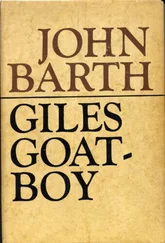But this apparently outermost frame — the tale of King Shahryar of “the lands of India and China,” his similarly-cuckolded and similarly-vengeful brother King Shah Zaman of Samarkand, and Scheherazade and her younger sister Dunyazade, which begins more than a thousand nights before Night 1 and winds up well after Night 1001—is itself framed, sort of, by an intriguing formulation (intriguing to some of us later storytellers, anyhow): In all versions, after the ritual invocation to Almighty Allah, the anonymous narrator-scribe declares in effect, not that “There once was a jealous king named Shahryar,” et cetera, but that “There is a book called The Book of a Thousand Nights and a Night , in which one will find the story of King Shahryar and his brother Shah Zaman [and Scheherazade and Dunyazade], which goes like this. . ” A thousand-plus nights later, after that so-productive young talester — talestress? — has delivered herself not only of those several hundred stories, but also of three male children (“one walking, one crawling, one suckling”) sired by her entertain-me-or-die consort, and has delivered the king as well from his pathologically murderous, kingdom-wrecking jealousy, she successfully pleads for her life, officially weds the father of her children and inspirer of her stories in a regally elaborate joint ceremony with her now older and less innocent kid sister and Shahryar’s up-till-then equally murderous kid brother, and the foursome are declared to have lived happily thenceforth — not “ever after,” as in Western fables, but more realistically “until the Destroyer of Delights and Severer of Societies and Desolater of Dwelling-places came upon them”: the standard wrap-up of Scheherazade’s own stories. Whereupon the successor to Shahryar’s throne (One of those three sons? We’re not told) discovers in the late and no doubt unlamented king’s treasury the tales that not only entertained him but saved his kingdom and their teller’s life, and which grateful Shahryar had therefore obliged his scribes to record after the fact in thirty volumes for posterity (another story: imagine weary Scheherazade having to recollect and re-tell all those tales to the royal clerks!); and said successor is so delighted with them that he has his scribes re-copy the whole shebang and “spread them throughout the world.”
Then comes the almost off-handed punch line: “As a consequence,” concludes this story-of-the-story-of-the-stories, “the tales became famous, and the people called them The Marvels and Wonders of the Thousand and One Nights. This is all that we know about the origins of this book, and Allah is omniscient. . FINIS.”
GET IT? THE book that we’ve just finished reading is not The Thousand and One Nights , exactly, but a book about a book called The Thousand and One Nights. FINIS indeed — and wow! But so lightly and engagingly does this outermost Scheherazade, so to speak, lead us into and out of the narrative labyrinth of tales within tales within tales, we’re scarcely aware of all this structural complexity. Nor need we be, any more than venturers through an amusement-park funhouse need appreciate the intricate mechanics of its serial gee-whizzes: quite okay just to go along for the ride, at least the first time through. Closer examination has its rewards, however, and may well lead one not only through this expertly edited two-volume Signet Classics version, but on to the ten- or twelve- or thirty-volume feast of which it is a rich sampling. Ms. Scheherazade is, among other things, a storyteller’s storyteller par excellence , whom writers as otherwise dissimilar as Johann Wolfgang von Goethe, Marcel Proust, Jorge Luis Borges, and Yours Truly have found irresistible. Goethe was impressed by the stories’ mix of fantasy and realism, humor and terror, delicacy and ribaldry, even downright scatology: his journals note that the author of The Sorrows of Young Werther was particularly taken with Night 410, the Tale of How Abu Hasan Farted. And as David Beaumont notes in his introduction to Volume I, Marcel Proust — whose seven-volume Remembrance of Things Past is itself a fiction of Scheherazadean proportions, though not of Arabian Nights flavor — frequently refers to her epical narrative in his. Likewise the late great Argentinian Jorge Luis Borges (who, being blind, was himself necessarily a story teller rather than a story-writer, composing his splendid ficciones in his head and then, like Scheherazade after her narrative menopause, dictating them from memory for inscription), and many another storyteller from all over the globe.
That’s no surprise to this one, who most certainly includes himself among the Vizier’s daughter’s long-time ardent admirers. As a child in the time before television, video games, and the Internet, I was charmed by a much-abridged and radically expurgated one-volume kiddie edition of the Nights , discreetly but handsomely illustrated by N. C. Wyeth. No gas-passing villagers in it, as in the tale that so amused Goethe (the unfortunate Abu Hasan, mortified by his accidental flatulence during a prayer-service, exiles himself for years; returning finally to his village in hopes that his embarrassing faux pas has long since been forgotten, he happens to overhear a lad ask his mother how old he is, to which she replies that he’s ten years old, he having been born “on the very night that Abu Hasan farted”); no lascivious sultanas cuckolding their royal spouses with ape-like “slobbering blackamoors” who swing down from the trees to service them and their handmaidens while hubby is out of town; no sad but dutiful Grand Vizier showing up at the king’s court every morning, shroud over his arm, expecting royal orders to lead his daughter off to execution as he has led her thousand deflowered predecessors — but there were Aladdin and his magical lantern, Ali Baba and the forty thieves, Sinbad the Seaman and Sinbad the Landman; there were the mighty wish-granting genies/jinnees/djinns in bottles and other innocent-looking containers (even as a kid, I wondered why it never occurs to Aladdin and other wish-grantees to cover their bets by wishing for more wishes !); there were the mermaids and dragons, the Open Sesames and other charms…. I was hooked.
And re-hooked for keeps years later, when — as an undergraduate book-filer in the Classics stacks of my university’s library, re-shelving cartful after cartful of tomes to help defray my tuition and eagerly perusing as I re-shelved, while at the same time feeling the first stirrings of writerly Vocation — in the alcoves of what was called the “Oriental Seminary” I discovered among other marvels the ten folio volumes of Somadeva’s enormous Katha Sarit Sagara : the 11th-century Sanskrit Ocean of the Streams of Story spun out by the god Shiva to his consort Parvati in reward for a particularly divine session of lovemaking. It contains not just tales within tales, but such entire cycles of tales-within-tales as the Panchatantra (“Five Principles”) and the Vetalapanchavimsati (“25 Tales Told by a Vampire”), and is assumed to be among the antecedents of the Persian Hazar Afsaneh (“Book of a Thousand Tales”) later translated and transmuted into the Arabic Book of a Thousand Nights and a Night . That too was there to be re-filed, in Burton’s version and others, as were (in neighboring alcoves) such frame-taled European spin-offs as Boccaccio’s ten-night Decameron , Marguerite of Navarre’s seven-night Heptameron , Giambattista Basile’s five-night Pentameron (or Tale of Tales ), and other more or less racy delights, none of which were included in my otherwise excellent world-lit undergrad survey courses. What wannabe fictionist wouldn’t lay into such a narrative smorgasbord?
Читать дальше












